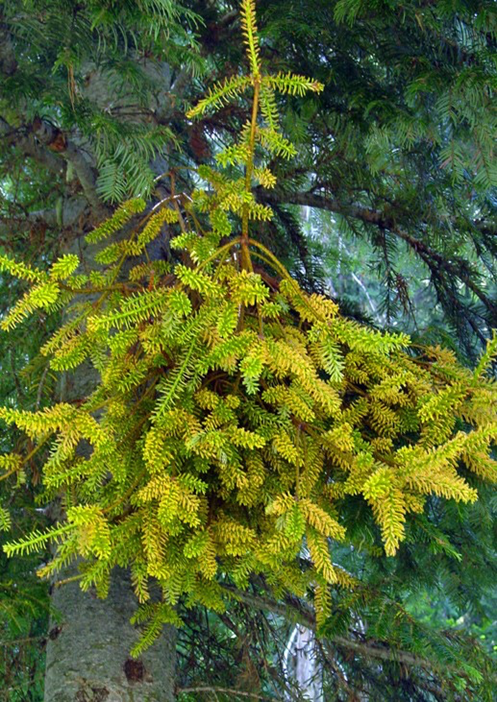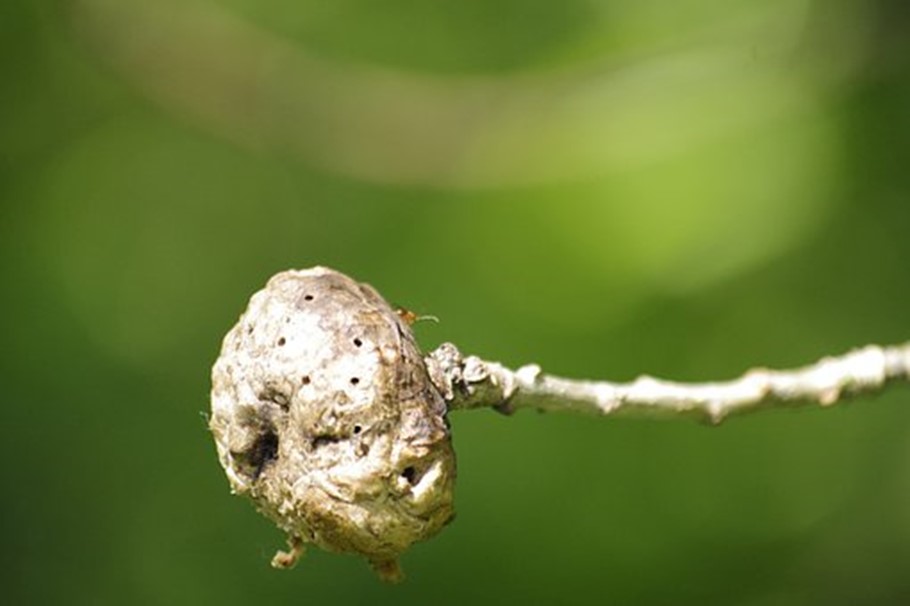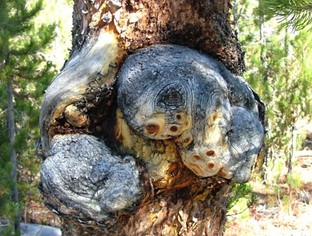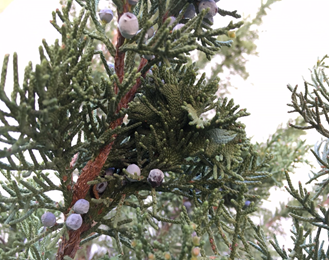041 - Can Trees Get Cancer?
Almost anyone who has looked at or been around trees very long has seen odd-looking, sometimes even tumor-like growths on tree stems and other parts that look different than the trees' regular growth. Though these growths tend to be benign (not harmful to the plant), some are harmful or disruptive to the host plant. All can be thought of as plant cancers, and the growths can be thought of as tumors, though they have crucial differences from cancers found on higher animals like humans.
Witches’ Broom

Fir broom rust fungus on subalpine fir (Abies lasciocarpa).
A common type of cancer-like growth found mostly in trees is called a witches’ broom. A witches’ broom is simply a proliferation of abnormal growth that forms on a woody plant, usually on twigs near the branch ends. It tends to grow in that abnormal state year after year, causing the shoot from which it grows to die due to disruption of the vascular system. It’s named witches’ broom because the abnormal growth resembles a broom head, with many short branches coming out of a common point. Instead of a tree’s canopy having relatively few, regularly spaced branches growing fairly quickly, a tree with witches’ broom will have a stunted but dense canopy.
An example of a tree commonly planted in Utah that often gets witches’ broom is the London planetree or sycamore (Platanus X acerifolia). The cause of witches’ broom in London planetree is a common disease that injures branch tips in the spring called sycamore anthracnose (Apiognomonia veneta). The cell death or mutation that occurs as a result of the disease causes the remaining live cells to develop abnormally, and when this happens year after year, it forms broom-like structures.
Hackberries (Celtis species) are also known to develop witches’ broom, but the cause is not clear. Witches’ broom also forms on many conifers like subalpine fir (Abies lasiocarpa) when infested with fir broom rust (Melampsorella caryophyllacearum). It also affects lodgepole pine (Pinus contorta) when infested with the parasitic plant dwarf mistletoe (Arceuthobium species).
Other types of tree “cancers” include galls, including burls, and flattened formations called fasciations.
Galls

Insect-caused tree gall. Picture credit: Pixabay
Galls are somewhat disorganized growths or tumors that can form on most parts of trees (and other plants). Galls and other tree tumors can be caused by bacteria, viruses, insects, and other organisms. However, once they start growing in their altered state, they often can continue growing, even if the original causal organism is no longer present. This implies that the altered growth may be caused by mutations in the genetics of the tree’s cells at the point of infection or attack. In fact, tree tumors often appear to have no obvious cause and may be caused by spontaneous genetic mutations in tree tissues.
Tree galls caused by insects are often tumor-like, and they occur on leaves or young stems that form in such a way that enables insects to live inside them. This protects them from predators while it allows them to feed on the tree’s sap or tissues.
A very common insect gall found on trees in Utah is hackberry nipple gall, formed by a small insect called a hackberry gall psyllid (Pachypsylla celtidismamma). This insect causes the formation of nipple-like galls on the undersides of hackberry leaves and then lives inside them. Insect-caused tree galls also are commonly found on willows and cottonwoods. Ants often cause galls on trees and other plants. Gall-forming insects may create chemicals that act as plant growth regulators, causing the plant to grow in the way it wants.
Burls

A tree burl in a tree trunk creates unusual wood shapes. Picture credit: Pixabay
Burls are woody galls that grow on tree stems, and especially on tree trunks. They tend to be more-or-less rounded. They grow relatively slowly, possibly because their disorganized growth means that they cannot develop a normal vascular system; therefore, they do not get enough water and nutrients to grow quickly. By definition, a burl is mostly made up of woody tissue surrounded by bark, and they are highly sought-after by woodworkers. Their disorganized growth makes for highly figured wood that can be turned on a lathe into bowls and other items. Burls often have small branches with leaves growing from their surface, and they may grow out of one side of the trunk, or they may even surround a tree’s trunk. Burls frequently grow on boxelder (Acer negundo), a common Utah-native tree.
Fasciations

Fasciation in Rocky Mountain juniper (Juniperus scopulorum).
Fasciations form similarly to galls and witches’ broom, but their growth proliferation takes place in two dimensions resulting in a flattened shoot, often growing profusely. Fasciations occur on over 100 plant families, including cacti and junipers. A small, non-woody, but perennial broadleaved plant grows in a patch of my lawn that appears to be a type of fasciation. Year after year, that plant comes back and surfaces in the lawn in its fasciated form.
Cancer Similarities and Differences
All of these growths can essentially be thought of as plant cancers and the growths can be thought of as tumors. Like cancers, they continue to grow until the plant they attach to can no longer support them. As they disrupt the vascular system, they break off or lose their source of water and other materials needed to survive. This is very similar to the way that some animal cancers harm or kill—by physically disrupting plant parts and by disrupting blood flow (though sometimes they cause extra blood flow to an area to "feed" the cancer).
The main difference between plant cancers and animal cancers is that they cannot easily spread to other parts of the plant or other plants. To get rid of a plant cancer, you prune the tumors or growths off below their point of attachment. Usually, they won't come back. At least they will not come back on that shoot. You may even want to remove a large burl on a branch or on the trunk to use it for woodworking, but it may be difficult to determine where to cut to minimize damage to the remaining tree.
So, the answer to the title question, “Can trees get cancer?” is not really, but sort of.
If you come across one of these formations, consider not cutting it off. Often, they look pretty cool, and they add interest to the landscape. Learn more about why they form and on which plants. They truly are wonders of nature.
All photos by Mike Kuhns unless otherwise noted.
Revised November 2020

